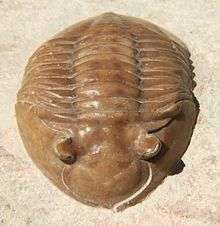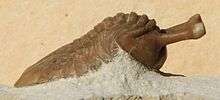Asaphus
| Asaphus Temporal range: upper Floian to Darriwilian | |
|---|---|
 | |
| A. latus | |
| Scientific classification | |
| Kingdom: | Animalia |
| Phylum: | Arthropoda |
| Class: | Trilobita |
| Order: | Asaphida |
| Family: | Asaphidae |
| Genus: | Asaphus Brongniart, 1822 |
| Species | |
| |
Asaphus is a genus of trilobites, that is known from the Lower (upper Arenig) and Middle Ordovician of northwestern Europe (Sweden, Estonia, Saint Petersburg Area).[1]
Etymology
The generic name is derived from the Greek word asaphes, meaning "indistinct."
Description

The headshield (or cephalon) and tailshield (or pygidium) are semicircular and without a border (defined by a furrow or a change in convexity parallel to its margin). The cephalon is of approximately equal size as the pygidium (or isopygous).
The central raised area of the cephalon (or glabella) is long, reaching the frontal margin. It may have faint lateral glabellar furrows or be smooth, and sometimes an inconspicuous tubercle is present just in front of the hardly discernible occipital ring. The natural fracture lines (sutures) of the head run along the top edges of the compound eye. From the back of the eye these cut to the back of the head (or is said to be opisthoparian) and not to the side. The free cheeks (or librigenae) are separated from each other anteriorly by a suture at the midline. The corner between the side and the back of the cephalon (or genal angle) is rounded or (in a few species) pointed into spines. Eyes holochroal, commonly more or less conical, short or moderate in length. In some evolution lines, the visual surface of the eye is raised on a stalk.
The lateral corners of the palate (or hypostome), visual from the ventral side, are more or less protruding, and the posterior part is forked with two triangular teeth. The reflexed margin of the exoskeleton (or doublure) is broad.
The articulate midlength part of the body (or thorax) consists of 8 segments. Furrows in the parts outside the axis (or pleural furrows) are diagonal.
The pygidium is rounded, and has a long axis with concave, posteriorly parallel sides. Some rings may be faintly defined anteriorly and the axis dissolves in the postaxial field. The areas outside the axis (or pleural fields) are smooth or very faintly ribbed.[2]
Diversity

|
|
Species previously assigned to Asaphus

As the genus Asaphus was established early, many species have since been reassigned to genera in various trilobite orders.[4]
|
|
References
- ↑ Martin Stein & Jan Bergström (2010). "Some lower Middle Ordovician species of Asaphus (Trilobita) from Sweden". GFF. 132 (2): 105–116. doi:10.1080/11035897.2010.486478.
- ↑ Moore, R.C. (1959). Arthropoda I - Arthropoda General Features, Proarthropoda, Euarthropoda General Features, Trilobitomorpha. Treatise on Invertebrate Paleontology. Part O. Boulder, Colorado/Lawrence, Kansas: Geological Society of America/University of Kansas Press. pp. O334–O436. ISBN 0-8137-3015-5.
- ↑ International Commission on Zoological Nomenclature (1982). "Direction 111 - Entomostracites punctatus Wahlenberg (Trilobita) (Official List Of Specific Names No. 1595): Date To Be Cited As [1818]". Bulletin of Zoological Nomenclature. 39.
- ↑ Moore, R.C. (1959). Arthropoda I - Arthropoda General Features, Proarthropoda, Euarthropoda General Features, Trilobitomorpha. Treatise on Invertebrate Paleontology. Part O. Boulder, Colorado/Lawrence, Kansas: Geological Society of America/University of Kansas Press. pp. O446 and O468. ISBN 0-8137-3015-5.
- 1 2 3 4 5 6 7 Osmólska, H. (1970). "Revision of non-cyrtosymbolinid trilobites from the Tournaisian-Namurian of Eurasia". Palaeontologia Polonica. 23.
External links
 Data related to Asaphus at Wikispecies
Data related to Asaphus at Wikispecies- drawings of many Asaphus species
- Website of the Saint-Petersburg Paleontological Laboratory
- Schematic of the relationships between the different species